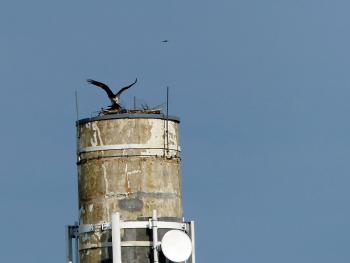CAMDEN — Despite the presence of construction workers, fire engines coming and going and plenty of foot traffic, the top of the smokestack alongside the Knox Mill in downtown Camden has become the spot for a pair of osprey to build a nest this spring.
Camden resident Janice Gates captured photos of the nesting pair of ospreys, as they appear to be building up their nest in anticipating of eggs and eventually chicks.
Ospreys are a common site around Camden Harbor and the Knox Mill pond below the smokestack, as they hunt for their favorite food - live fish. Ospreys seem to enjoy riding the thermals high in the sky, though they are probably scouting for fish below during these flights. Ospreys are often confused with juvenile bald eagles, which bear similar markings of dark and white feathers on their undersides. But an osprey can be identified by it’s white belly and breast, with white extending to under its wings, and the bend it its wings when it flies, making an “M” shape. It also has a smaller beak, glowing yellow eyes, is more lean than an eagle and overall is a bit smaller in stature too.
Ospreys also often make a lot of noise while flying overhead, unlike an eagle, which flies nearly silent. They have also done a good job of monopolizing Camden Harbor, making sightings of bald eagles in town not as common as it used to be when they too were nesting and raising young, in particular on Curtis Island.
According to Cornell University and its Lab or Ornithology, “ospreys search for fish by flying on steady wingbeats and bowed wings, or circling high in the sky over relatively shallow water. They often hover briefly before diving, feet first, to grab a fish. You can often clearly see an osprey's catch in its talons as the bird carries it back to a nest or perch.”
And an osprey often lines up its catch so its is carried head first, for less wind resistance, as the raptor flies back to its nest or perch to eat.
This is not the first time ospreys have nested atop the Knox Mill smokestack. Almost two years ago to the date, two boys discovered an osprey on May 26, 2014, that had fallen down and inside the 180-foot-tall smokestack, and was trapped at the bottom behind a locked metal door. A waitress at a nearby restaurant, who also happened to have experience rescuing and rehabilitating birds, overheard the boys find and came the osprey’s aid. Tired, stressed and a little thin, that osprey was freed from its predicament and released back outside, and it eventually flew away toward the harbor.
Also found inside the smokestack tower that day were large sticks, indicative of an osprey nest high above. It’s likely the raptor was sitting on the nest, or attempting to, when it gave way and sent the bird to the ground below. Since that event, the tower’s owner has placed a grate over the top of the smokestack, which is also now home to an array of Internet, cable and cellular phone equipment.
Osprey nests are built of sticks and lined with bark, sod, grasses, vines, algae, or flotsam and jetsam, according to Cornell. The male usually fetches most of the nesting material—sometimes breaking dead sticks off nearby trees as he flies past—and the female arranges it. Nests on artificial platforms, especially in a pair's first season, are relatively small—less than 2-1/2 feet in diameter and 3-6 inches deep. After generations of adding to the nest year after year, Ospreys can end up with nests 10–13 feet deep and 3–6 feet in diameter.
Once the ospreys build the nest and the female begins to lay eggs, the clutch consists of between one and four eggs. Incubation is between 36 and 42 days, and nestling period is 50-55 days. Hatching is staggered, with the first chick appearing up to five days before the next. Like other birds, including eagles and loons, the older hatchling dominates its younger siblings and can monopolize the food brought by the parents. If food is abundant, chicks share meals in relative harmony; in times of scarcity, younger ones may starve to death.
If the smokestack ospreys build a solid nest, and there aren’t any major wind storms to knock it off it’s perch high in the sky, this mating pair could be welcoming young soon. And then the show will be watching mom and dad bring fish to their growing brood, until eventually the fledglings take their first flights.
Related links:
• Cornell Lab or Ornithology: Osprey
Reach Editorial Director Holly S. Edwards at hollyedwards@penbaypilot.com and 207-706-6655.


Osprey-Nest2.jpg)


























